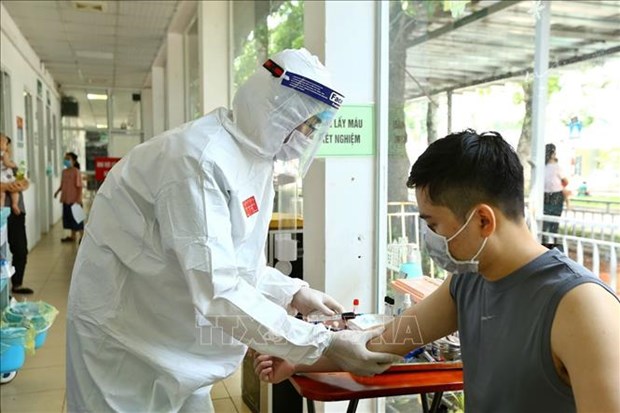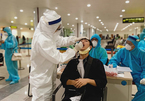 |
|
A health worker takes a blood sample for SARS-CoV-2 testing at Hanoi's Thanh Nhan Hospital.
|
According to the ministry, there were 137 laboratories capable of conducting RT-PCR tests to detect SARS-CoV-2 in Viet Nam, with a maximum testing capacity of 51,125 samples per day.
Of those laboratories, 75 are qualified to confirm COVID-19 cases with a maximum capacity of 40,550 samples per day.
As of September 20, over one million samples had been tested for SARS-Cov-2. About 0.1 per cent of the samples returned positive. This figure shows that as the world is facing a shortage of the biological products used for testing, it is very important to prioritise key vulnerable groups.
The guidance clarifies prioritisation in three specific stages.
In the first stage when COVID-19 is detected but the disease has yet to spread widely in the community, first priority is given to those who have close contact with suspected/confirmed cases, COVID-19 patients who are under treatment, and those who are hospitalised for having cough and at least one symptom of respiratory disease.
Asymptomatic health workers, care givers and staff who have close contact with confirmed COVID-19 cases within 14 days without proper protective measures, for example face masks and protective suits, should be tested first.
Those who enter Việt Nam, arrive in quarantine areas or leave quarantine areas will also be tested. People living in disease clusters which are locked down are also in the first priority testing group.
Second priority goes to people with symptoms related to COVID-19 or face high risk of critical diseases, for examples those with underlying medical conditions, elderly patients or those who have been hospitalised for a prolonged period. Asymptomatic health workers employed in hospitals which treat COVID-19 patients or those who want to go overseas also need testing.
Third priority is given to high-risk communities and vulnerable groups.
In the second stage with wide-spread infection in community, first priority is given to those who have symptoms of critical pneumonia, high possibility of having COVID-19, symptomatic health workers/care givers/ hospital staff or people who stay at collective accommodation like quarantine areas, campuses or nursing homes and have suspected symptoms of COVID-19.
Second priority is given to those who are hospitalised with a cough and at least one symptom of respiratory disease. High-risk patients who have underlying health conditions aged from 60 and have symptoms relating to COVID-19 are also in this group.
People who work on disease prevention and control measure who show COVID-19 symptoms will all be tested.
Second priority is also given to asymptomatic health workers employed by hospitals with COVID-19 patients, or when the first suspected case is reported in an area.
Third priority is given to those living in high-risk areas and vulnerable groups.
In the third stage without community infections and only imported cases are reported, first priority is given to those who had had close contact with suspected/confirmed cases, COVID-19 patients who are under treatment, and those who are hospitalised with a cough and at least one symptom of respiratory disease.
People who have entered the country, arrive in quarantine areas or are set to leave quarantine areas in 1-2 days will also be tested.
Second priority is given to those living in high-risk areas and vulnerable groups.
The National Institute of Hygiene and Epidemiology, the Pasteur Institute, local health departments and centres for disease control and SARS-CoV-2 laboratories are required to report their testing activities to the ministry.
Producers/suppliers of biological products used for testing are also required to report their production/supply capacity as well as the quality of their products. — VNS

Passengers must spend 6 days at concentrated quarantine centers after entering VN
With two continuous tests of negative results after their entry, those who enter Vietnam to work for a period of over 14 days can go home or to their accommodations for self-isolation, according to the latest Ministry of Health’s temporary guide.